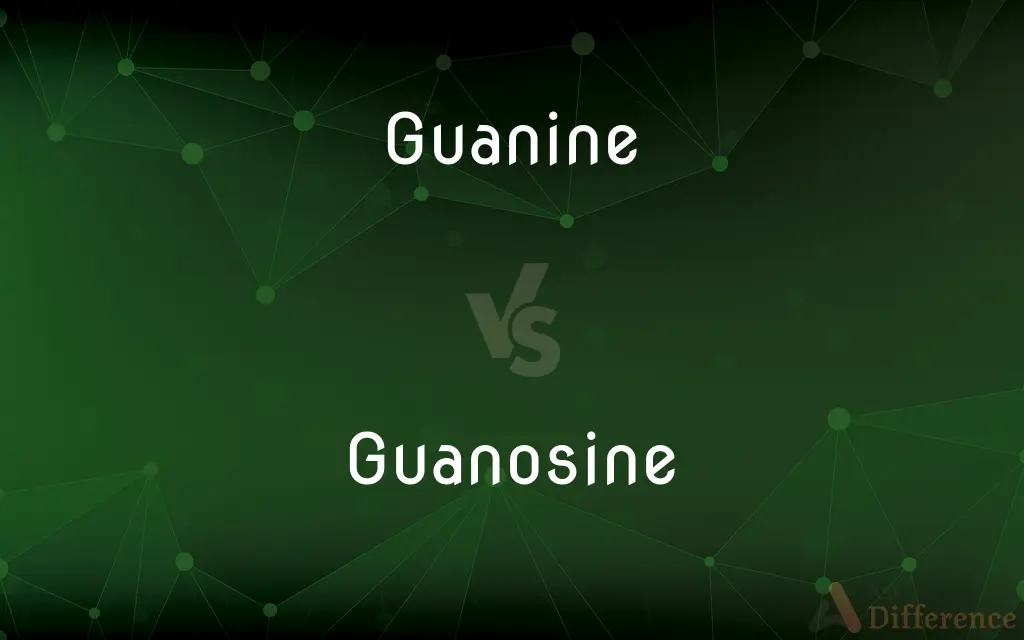Guanine vs. Guanosine — What's the Difference?
By Tayyaba Rehman — Updated on September 28, 2023
Guanine is a nitrogenous base found in DNA and RNA, while Guanosine is a nucleoside composed of guanine attached to a ribose sugar.

Difference Between Guanine and Guanosine
Table of Contents
ADVERTISEMENT
Key Differences
Guanine and Guanosine are both crucial components in the molecular structure of DNA and RNA, yet they serve different roles. Guanine is one of the four primary nitrogenous bases in DNA and RNA, playing a critical part in the encoding of genetic information. Its counterpart in DNA pairing is cytosine, forming a bond that's pivotal for DNA's double-helix structure. Conversely, Guanosine refers to the combination of the guanine base with a ribose sugar molecule, classifying it as a nucleoside.
The distinction between Guanine and Guanosine is rooted in their molecular composition. While Guanine is solely the nitrogenous base, Guanosine involves an additional component - the ribose sugar. This sugar is what classifies it as a nucleoside and distinguishes it from its base-only counterpart.
When discussing the role of these molecules in genetic material, Guanine is the component that interacts with other bases to form the rungs of the DNA ladder. Its ability to pair with cytosine is foundational for the stability of the DNA molecule. On the other hand, Guanosine, as a nucleoside, can be further phosphorylated to produce nucleotides, the building blocks of DNA and RNA.
In the broader biochemical landscape, both Guanine and Guanosine have functions beyond DNA and RNA. Guanine, for instance, is also found in other molecules like GTP, a vital energy-carrying molecule in cells. Guanosine, meanwhile, plays roles in various cellular processes, including cell signaling.
From a practical standpoint, understanding the difference between Guanine and Guanosine is pivotal for professionals in genetics and biochemistry. Their unique properties and functions mean they aren't interchangeable, emphasizing the importance of accurate terminology in scientific contexts.
ADVERTISEMENT
Comparison Chart
Composition
Nitrogenous base only.
Guanine base attached to a ribose sugar.
Role in DNA/RNA
Pairs with cytosine to form DNA rungs.
Forms nucleotides, the building blocks of DNA and RNA.
Classification
Nitrogenous base.
Nucleoside.
Presence in
Found in DNA, RNA, and molecules like GTP.
Found in DNA, RNA, and involved in various cell processes
Interaction with
Interacts with cytosine in DNA.
Can be phosphorylated to produce nucleotides.
Compare with Definitions
Guanine
A nitrogenous base present in both DNA and RNA
Guanine pairs with cytosine in the DNA structure.
Guanosine
A nucleoside combining guanine and ribose
Guanosine is a precursor to essential nucleotides in DNA and RNA.
Guanine
One of the four primary building blocks of genetic code
Guanine codes for specific amino acids in proteins.
Guanosine
A derivative of the guanine base
Guanosine represents the guanine base attached to a sugar molecule.
Guanine
A component in several biological molecules
Guanine is a vital part of the GTP molecule.
Guanosine
A molecular unit in the structure of RNA
Guanosine plays a crucial role in RNA synthesis.
Guanine
A purine derivative essential for life
Without guanine, the genetic makeup of organisms would be incomplete.
Guanosine
A compound involved in cellular processes
Guanosine triphosphate is vital for energy transfer within cells.
Guanine
A molecule that forms hydrogen bonds with cytosine
The guanine-cytosine bond is strong, ensuring DNA's stability.
Guanosine
A biochemical component in cell signaling
Certain guanosine derivatives play roles in cell-to-cell communication.
Guanine
Guanine (; or G, Gua) is one of the four main nucleobases found in the nucleic acids DNA and RNA, the others being adenine, cytosine, and thymine (uracil in RNA). In DNA, guanine is paired with cytosine.
Guanosine
Guanosine (symbol G or Guo) is a purine nucleoside comprising guanine attached to a ribose (ribofuranose) ring via a β-N9-glycosidic bond. Guanosine can be phosphorylated to become guanosine monophosphate (GMP), cyclic guanosine monophosphate (cGMP), guanosine diphosphate (GDP), and guanosine triphosphate (GTP).
Guanine
A purine base, C5H5ON5, that is an essential constituent of both RNA and DNA.
Guanosine
A nucleoside, C10H13N5O5, consisting of guanine and ribose.
Guanine
(chemistry) A substance first obtained from guano; it is a nucleic base and pairs with cytosine in DNA and RNA (by means of three hydrogen bonds).
Guanosine
A nucleoside derived from guanine and ribose
Guanine
A purine base found in DNA and RNA; pairs with cytosine
Guanosine
A nucleoside component of DNA; composed of guanine and deoxyribose
Common Curiosities
Can Guanine exist outside of DNA and RNA?
Yes, Guanine can also be found in molecules like GTP.
What's the primary role of Guanosine in RNA?
Guanosine forms nucleotides, the building blocks of RNA.
Are Guanine and Guanosine the same thing?
No, Guanine is a nitrogenous base, while Guanosine is a nucleoside comprising guanine and a ribose sugar.
Which one is a nucleoside?
Guanosine is a nucleoside, while Guanine is not.
Does Guanine pair with any other base in DNA?
No, Guanine specifically pairs with cytosine in DNA.
Why is the Guanine-Cytosine bond crucial for DNA?
The Guanine-Cytosine bond provides stability due to its three hydrogen bonds.
What does Guanosine transform into for energy transfer?
Guanosine transforms into Guanosine Triphosphate (GTP) for energy transfer.
Which molecule contains a ribose sugar component?
Guanosine contains a ribose sugar, not Guanine.
Is Guanosine's presence limited to RNA?
No, Guanosine forms nucleotides in both DNA and RNA.
Is Guanosine involved in energy transfer in cells?
Yes, especially in the form of guanosine triphosphate or GTP.
Can Guanosine be found in DNA?
Yes, but in the form of nucleotides when combined with phosphate groups.
Can Guanosine be converted to a nucleotide?
Yes, by adding phosphate groups to Guanosine.
Which molecule directly interacts with other nitrogenous bases?
Guanine directly interacts, especially with cytosine.
What makes Guanine different from other nitrogenous bases?
Guanine has a unique structure and bonding pattern, specifically pairing with cytosine.
Are Guanine and Guanosine both purine derivatives?
Yes, both are derived from the purine structure.
Share Your Discovery

Previous Comparison
Cupid vs. Greed
Next Comparison
Jacket vs. HoodieAuthor Spotlight
Written by
Tayyaba RehmanTayyaba Rehman is a distinguished writer, currently serving as a primary contributor to askdifference.com. As a researcher in semantics and etymology, Tayyaba's passion for the complexity of languages and their distinctions has found a perfect home on the platform. Tayyaba delves into the intricacies of language, distinguishing between commonly confused words and phrases, thereby providing clarity for readers worldwide.















































